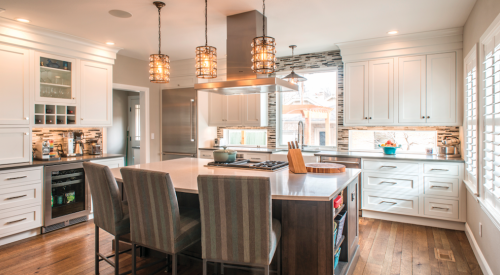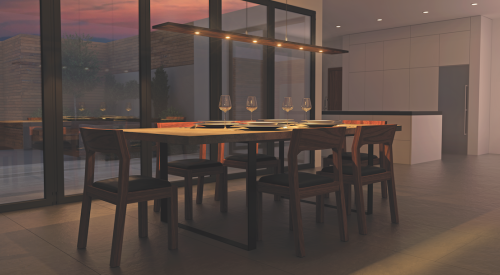If you're like many home builders, you install recessed downlights or "can lights" more than any other light fixture. These simple fixtures have become more prevalent during the past 15 years, and many new homes today have 20, 30 or more of them. According to research by the U.S. Department of Energy's Pacific Northwest National Laboratory, the recessed can is the most popular installed lighting fixture in new and remodeled homes, with at least 350 million currently installed and 20 million more sold each year.
Two emerging issues should encourage builders to take a closer look at recessed downlights: growing consumer interest in energy efficiency, and building energy codes addressing air leakage and moisture transfer.
When installed in the building shell, recessed can fixtures that are not airtight let conditioned air leak into unconditioned spaces such as attics. In cold regions, heated air leaking through can lights has melted snow on roofs and caused destructive ice dams. Even in milder climates, air leakage wastes heating and cooling energy, making utility bills higher than necessary. In addition, moisture-laden air can migrate through recessed fixtures into attics and condense, creating moisture problems for the drywall and framing.
Concerns about moisture damage and energy waste have led building energy code organizations to adopt strict airtightness requirements for recessed ceiling fixtures installed in the building shell (reference test procedure ASTM E-283). The 1995 Model Energy Code and the 1998/2000 International Energy Conservation Code include these requirements. To date, 33 states representing more than 67% of the U.S. population have adopted these codes.
Utility Costs
Codes address air leakage, but recessed cans also can save lighting energy with the right lamps. Almost all recessed downlights sold in the United States use incandescent lamps. Standard incandescent fixtures waste energy: 90% of the energy an incandescent bulb consumes is wasted as heat; only 10% is converted into light. Compact fluorescent lamps (CFLs) use one-third to one-half the energy of an incandescent bulb while providing the same amount of light.
Most recessed downlights provide general or ambient illumination, for which CFLs can be a good substitute. These lamps last eight to 10 times longer than an incandescent bulb, so homeowners make fewer trips up the ladder to change lamps. This can be especially important in homes with high cathedral ceilings or other hard-to-reach areas.
Why should home builders care? A recent survey by research organization Ipsos-Public Affairs reveals growing consumer interest in energy efficiency. In the September 2003 survey of homeowners age 25 and older, 90% of respondents said they would take action to prevent over-consumption of energy if they knew what to do. More than half also reported purchasing an Energy Star-qualified product.
Builders might be familiar with Energy Star, a program sponsored by the DOE and the Environmental Protection Agency, as it applies to new homes, but it includes a distinct consumer angle as well. Energy Star's voluntary labeling program helps consumers identify energy-efficient products such as CFLs, light fixtures, appliances, air conditioners, windows and furnaces. Energy-efficient, low-maintenance lighting is another value-added feature that builders can offer their customers.
|
Energy-Efficient Recessed Can Fixtures That Passed DOE's Testing
|
|||||||||||||||||||
|
|||||||||||||||||||
Higher Efficiency
Recognizing the need to make more energy-efficient, CFL-based recessed can fixtures available to home builders and homeowners, the DOE is sponsoring the Recessed Downlights Project. This project encourages lighting fixture manufacturers to develop and bring to market high-efficiency recessed cans that perform well in airtight, insulated ceilings and meet Energy Star requirements for residential light fixtures.
Insulated ceilings represent a particular challenge for CFLs because heat can build up in the fixture. High temperatures can decrease ballast life significantly and therefore shorten the fixture's useful life. The new DOE program seeks to address this problem by working directly with fixture manufacturers to test new products and promote those fixtures that pass.
On behalf of the DOE, Pacific Northwest National Lab invited manufacturers to submit new fixtures that use pin-based CFLs rated for at least 10,000 hours of life, have an airtight housing to prevent air and moisture leakage into unconditioned spaces, and carry the IC rating for direct contact with insulation. Fixtures submitted for testing also must use electronic ballasts for quiet, flicker-free operation and have fixture efficiency of at least 50%, meaning the reflector is designed so that at least half of the light from the CFL projects out of the fixture as useful illumination.
PNNL then runs these downlights through rigorous testing to assess their performance in a simulated insulated ceiling. First, the fixtures are subjected to a short-term (12-hour) thermal test to verify that the ballast operating temperature would remain below its rated maximum, even when immersed in insulation. Fixtures surviving that test then undergo a full year of continuous cyclic testing (three hours on, 20 minutes off) in a simulated insulated ceiling environment, approximating eight years of typical operation.
To date, seven fixture models have passed (see table). Except where noted, all tests were conducted using 26-watt CFLs and non-dimming ballasts. In some cases, higher lamp wattages are available from the participating manufacturers, but results from these tests are not transferable to fixtures with higher installed lamp wattages.
Kelly Gordon, program manager at PNNL, can be contacted at 503/417-7558 (fax: 503/417-2175) or kelly.gordon@pnl.gov.
Aperture - The diameter, expressed in inches, in the opening of a downlight. Sometimes manufacturers round up to the next whole inch.
Ballast - A device used to operate fluorescent and high-intensity discharge lamps. The ballast provides the necessary starting voltage and limits and regulates the lamp current during operation.
CFL - Compact fluorescent lamp (also called PL, Twin-Tube or BIAX lamp). A small fluorescent lamp often used as an alternative to incandescent lighting. Compared with incandescent lamps, CFLs last eight to10 times longer and provide three to four times more light per kilowatt-hour of electricity consumed. CFLs may be pin-based or have a screw-in base to directly replace incandescent light bulbs.









